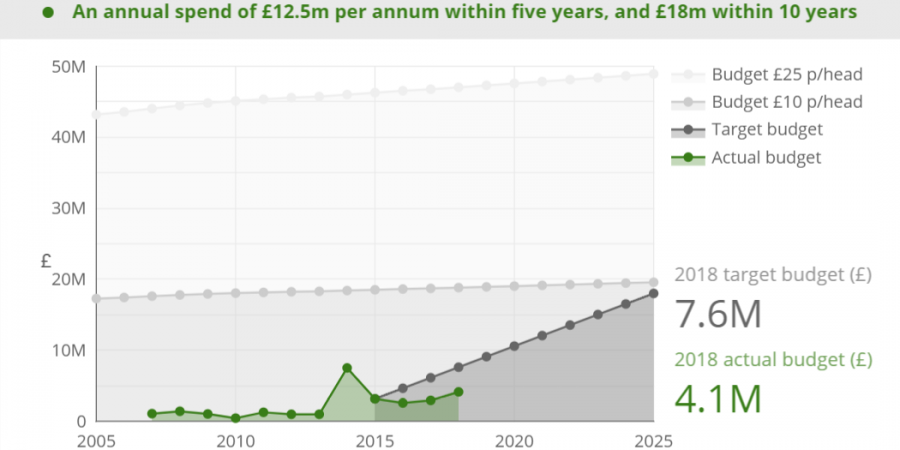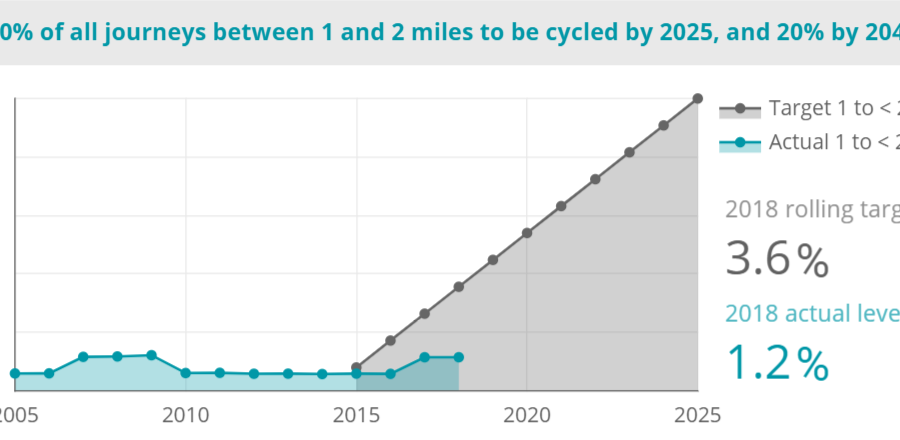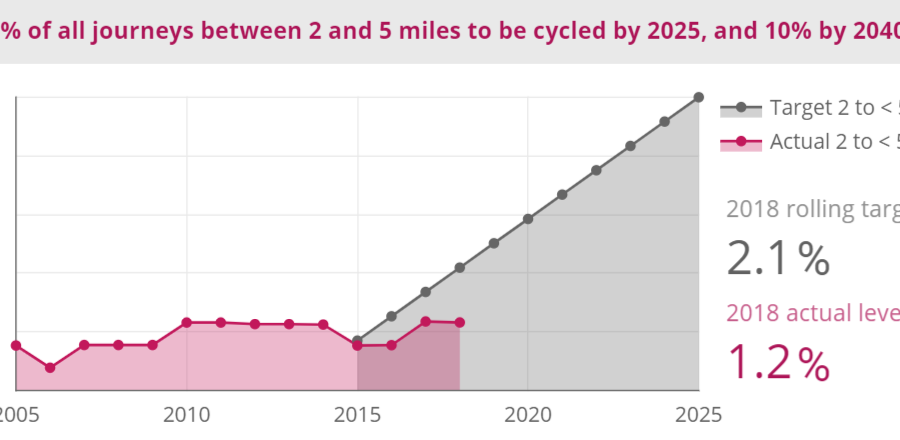(Updated 13 February 2020)
The Department for Infrastructure (DfI) is rapidly falling behind most of its main policy responsibilities on cycling. Now in its fifth year, the Bicycle Strategy for Northern Ireland’s main performance indicators are flat-lining due to a lack of priority, resourcing and staff.
The absence of the Northern Ireland Assembly and Executive has not been the main factor in this failure, but it has prevented the scrutiny of the Committee for Infrastructure and wider public knowledge of just how bad the situation is. The scale is probably unknown to DfI senior management.
To help level the playing field between DfI and those interested in actual delivery of change in cycling conditions, we’ve created a series of policy dashboards. These take the key outcome targets from the Bicycle Strategy and apply what real world data there is to measure performance to date.
The results are a call to action – for new Infrastructure Minister Nichola Mallon to direct DfI to stop the rot, to politicians to advocate for immediate progress, and to the wider public to demand ongoing delivery to make cycling safe and attractive enough to enable anyone in society to switch from car to bike.
Budget
In the years before the Bicycle Strategy for Northern Ireland, cycling measures were chronically underfunded in Northern Ireland. The benchmark for any country wanting to create the conditions for a mass uptake of cycling is the Netherlands, or Copenhagen in Denmark, where annual investment levels hover around the £25 per head of population mark.
In some pre-Strategy years the investment level in Northern Ireland was closer to 50p per head of population.
But the Bicycle Strategy was intended to put us on a path towards genuinely game changing investment levels, and critically on a stable footing of knowing the budget several years ahead to allow for long term planning, not short term pecking for crumbs.
So a clear escalating budget framework was set.
An annual spend of £12.5m per annum within five years, and £18m within 10 years
The Bicycle Strategy intended to bridge the gap between NI’s historically poor cycling investment and the consensus £10 per head of population needed to begin the propagation of real cycling growth – if still far short of the continental best.
We’ve estimated the year-on-year budget growth required to reach £18 million by 2025, with 2015’s actual budget as the starting point.
Over the past three years the actual annual cycling budget has averaged at just 54% of that rolling target budget.
To gauge how serious DfI and the new Minister are about the Bicycle Strategy, the rolling target budget for 2020/21 will be £10.5 million. The actual budget will be being discussed by DfI in the coming months. Politicians need to ask what the current indication for that budget will be, and the reasons for any anticipated shortfall.
Cycling growth
The Travel Survey for Northern Ireland (TSNI) provides journey data by mode and distance to allow us to benchmark performance against the three main Bicycle Strategy targets for growth in cycling. The latest report covers up to 2018.
20% of all journeys less than 1 mile to be cycled by 2025, and 40% by 2040
That’s an ambitious target for a fifth of all journeys in Northern Ireland under one mile to be cycled within the next six years.
From 2014 to 2018 the TSNI survey has not reported a figure for cycling journeys under one mile, marking instead as “negligible (less than 0.5 (including 0)).“
Northern Ireland has never recorded cycling levels above one per cent of all journeys under one mile in length.
At this distance, the comparison figures for journeys by other modes are:
- Walking 66%
- Public transport 1%
- Private motorised 34%
10% of all journeys between 1 and 2 miles to be cycled by 2025, and 20% by 2040
There is no evidence of a growth trend in cycling in the journey range of between 1 and 2 miles.
The cycling share of journeys at this distance is now just one third of the target level set by the Bicycle Strategy.
At this distance, the comparison figures for journeys by other modes are:
- Walking 31%
- Public transport 2%
- Private motorised 66%
5% of all journeys between 2 and 5 miles to be cycled by 2025, and 10% by 2040
There is no evidence of a growth trend in cycling in the journey range of between 2 and 5 miles.
The cycling share of journeys at this distance is now just half of the target level set by the Bicycle Strategy.
At this distance, the comparison figures for journeys by other modes are:
- Walking 8%
- Public transport 6%
- Private motorised 85%
For more detail on the data sources, access this dashboard via:
Bicycle Strategy key targets and outcomes (PDF, 355K)
Bicycle Strategy key targets and outcomes (Google Data Studio report)
New infrastructure
There are two key strands to cycling infrastructure delivery:
- off road shared use paths, eg greenways, blueways, parks (primarily rural)
- road and street networks, eg protected cycleways, filtered permeability (primarily urban)
There have been no new greenways delivered yet under the framework of the Bicycle Strategy.
Recently almost half a million pounds was committed to widening and improving the existing Comber Greenway. While welcome for current and potential users, this didn’t add to the total network length of greenways in Northern Ireland – 1,000km are planned to be delivered within the next 20 years.
Many greenway projects are progressing – projects in Derry City, the North West Greenway Network, the Carlingford Lough Greenway owe more to local councils and cross border organisations than DfI – and many councils have availed of DfI and Public Health Agency funding to progress greenway plans to feasibility and advanced readiness stage.
The urban cycling networks strand was focused on kickstarting the cycling revolution in Belfast and moving outwards to other urban centres.
Belfast’s existing “network” in 2015 totalled around 28km – protected cycleways, greenways, blue infrastructure along the Lagan, Belfast Harbour and Lough and routes across parks which link into other cycling infrastructure, eg Botanic and Ormeau.
Once DfI’s early schemes were completed in 2017 – Alfred Street, Castle Street to the Westlink – eight years of constructing or upgrading 12.5km of cycleways per year would be needed to see the “Primary Network” finished by 2025.
To date just 3km has been delivered out of an anticipated 27km, leaving the Belfast Bicycle Network two years behind schedule and falling further behind each year.
Even the projects completed in 2018 were delayed “early schemes” – an existing cycleway on Ann Street which got wand protection added, and the Middlepath Street cycleway which had been worked on since 2015.
So at Friday’s event, this is the key bit: most of the plans deal with Belfast City Centre, whereas *this* is radical pic.twitter.com/tVj20HWC1e
— NI Greenways (@nigreenways) August 19, 2015
While there are 5km of cycling projects listed as “In progress”, almost all are still on a desk somewhere in DfI.
Bikefast attended a Belfast City Council City Growth and Regeneration Committee on 28 November 2018 to present on the Belfast Bicycle Network. The head of DfI Roads Eastern Division described the “In progress” slate of projects (picture below) as an “extensive programme”.

The same projects are still “In progress” a year later.
To date just the Broadway roundabout scheme has broken ground, while others are unlikely to be delivered by this time next year, facing opposition from both residents and cycling groups tired of the wrong types of infrastructure in the wrong place. The Castle Street scheme has been on that list since 2016.
Even if DfI completed all of those schemes by the end of 2020, they would still be over 7km short of their in-year target, and by that stage around 40km short of the Bicycle Strategy’s overall delivery schedule for Belfast.
As ever, the talk is extensive, but the delivery is elusive.
For more detail on the data sources, access this dashboard via:
Belfast Bicycle Network progress (PDF, 212K)
Belfast Bicycle Network progress (Google Data Studio report)
“To achieve the vision for cycling we need to build a comprehensive network for the bicycle, support people who choose to travel by bicycle and promote the bicycle as a mode of transport for every day journeys.”
Minister Danny Kennedy, Bicycle Strategy for Northern Ireland
This statement in the Bicycle Strategy has not been followed by action from the Department for Infrastructure to the level required to match its own stated ambitions. DfI and its predecessor Departments did well at the supporting and promoting bit, but never took the key part seriously – “build a comprehensive network”. Since the Bicycle Strategy was published, the same pattern has unfortunately held.
The budget has not been allocated to cycling, the cycling infrastructure has not been delivered, and the real world outcomes are exactly what you would expect of a failing strategy shepherded by a largely disinterested organisation – no cycling growth.
In the era of climate emergency requiring radical action on transport, the era of awful congestion due to Northern Ireland’s over-reliance on private motor travel, the era of high levels of inactivity and obesity harming this and future generations, the era of desperate air quality scourging our lungs, it’s time to ask if the Department for Infrastructure is fit for purpose when it comes to our cycling strategy.









Awful…but just puts in words what is evident on the ground. In the next article please inform us how to get involved. Thanks
There are too many contrived ‘solutions’ to this crossover place where ‘inner box’ meets ‘Glider-emphasised’ access to the city centre.
It’s been a half baked junction for years since its traffic flows were hurriedly cobbled together to allow the closure of Chichester Street to facilitate security provision for the courts, resulting in the later landscaped place made with investments in hard and soft landscaping.
It is unrealistic to expect free movement here for people on foot or wheels of any description.
Let’s draw some wider pictures of the area of conflict and look at them creatively, together, with our felt pens in hand.
Good use of temporary coned/pot plant proposals on an experimental basis would be a great ‘next step’ with very easy and quick changes until we get it right.
[…] make the highest quality implementation happen. If anyone in DfI disagrees, show me any different. When the head of DfI Roads Eastern Division boldly declared to Belfast councillors in November 2018 …, who knew that the only item from that list which would be built two and a half years on would be a […]